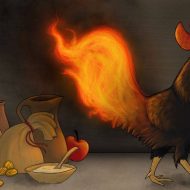Aitvaras : The Flaming Rooster
Listen
At a glance
| Description | |
|---|---|
| Origin | Baltic Mythology |
| Classification | Animals |
| Family Members | N/A |
| Region | Lithuania |
| Associated With | Riches, Shapeshifting, Fires, Human Interaction |
Aitvaras
Introduction
The Aitvaras is a type of flying dragon/rooster in Baltic mythology that has been depicted as a luck-bringer or a trickster spirit. They are also referred to as household spirits, little demons, and even nature spirits. It is an unpredictable creature that can transform into various forms depending on its current environment. For instance, it can look like a black cat or a black cockerel inside the house.
As a type of serpent, the Aitvaras have the head of a lucky grass snake. They can transform into various shapes and can fly at any time. They are powerful creatures that lived in the forests and roamed the wilds. They can be persuaded into becoming a family guardian or protector. As a guardian, they can bring wealth and happiness to anyone they choose.
Before Christianity, the Aitvaras were regarded as semi-divine creatures that could protect a family or a household. They were also used to regulate the wealth of people in their communities.
Physical Traits
As a species, Aitvaras have various descriptions and one of these is their ability to transform into various shapes. They also appear in various cultures, usually as a rooster or a black cockerel that will appear inside a house or a barn. At other times, they may appear as a black cat. Outside, an Aitvaras can transform into a flying serpent or a flaming snake and can also appear as a comet or a meteorite when it flies through the air.
Family
Little is known about the reproduction of Aitvaras. In order to create one, a rooster or a seven-year-old cockerel must lay an egg. It is then kept warm under the armpit until the Aitvaras emerge. The Aitvaras are known to eat leftover food from their households. However, they are also likely consuming milk, eggs, and grain stolen from nearby animals.
Other Names
Aitvaras is also known by other names, such as Atvaras, Damavykas, Pūkis, Sparyžius, Koklikas, Gausinėlis, Žaltvikšas, and Spirukas, and is identical to the Latvian Pūķis. It is not clear what origin the word Aitvaras comes from. Some believe it originated from the word aitauti, while others think it originated from the word tverti.
Powers and Abilities
Aitvaras are both good and evil. They can cause fires and destroy crops, and they can also bring people wealth. Most people do not know that they have an Aitvara, even as their houses are filled with good things. Aitvaras looks after good people that are not greedy or those that are abused by others; it brings them all kinds of fortune: cereal, flax and money that they usually take away from those who are wealthy and greedy.
Aitvaras are also capable of healing themselves by touching the Earth. However, some people have also killed the creatures to get rid of them from a household.
Modern Day Influence
After Christianity was introduced, Aitvaras became more of a negative creature that steals and does wrong, yet people still remember it as a helper who brings fortune.
Related Images
Frequently Asked Questions
What is the myth of the Aitvaras?
Aitvaras, a fiery Lithuanian house spirit, steals from the greedy and brings luck to the kind, but beware its unpredictable mischief.
What is the deity Aitvaras?
Aitvaras isn’t exactly a deity in Baltic mythology. It’s more akin to a powerful, shape-shifting house spirit or nature creature.
What is the Aitvaras bird?
The Aitvaras itself isn’t strictly a bird, though it can take the form of a fiery bird or rooster. It’s a shape-shifting creature in Lithuanian mythology. Imagine a fiery dragon that can also be a mischievous rooster!






